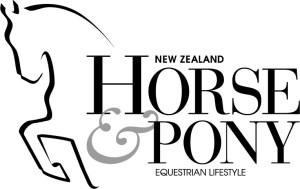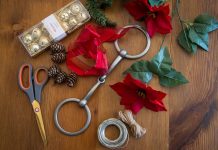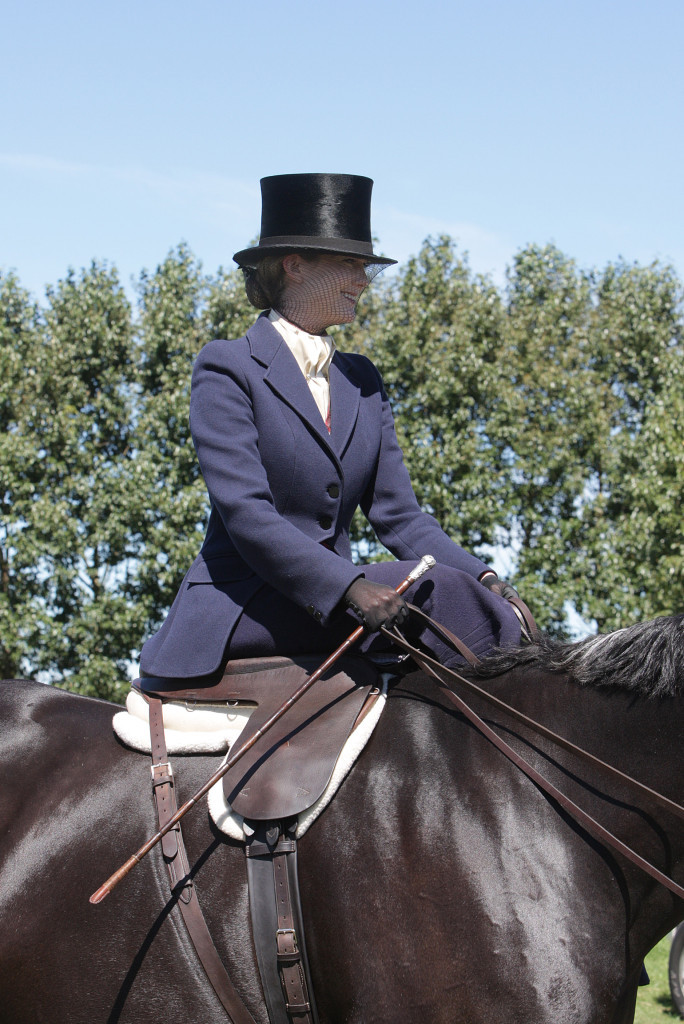 I love the overall picture of side-saddle, the fashion and romantic notion of ladies and gentlemen hacking around the English countryside. And having my first side-saddle encounter, I felt like I walked out of a Jane Austen movie.
I love the overall picture of side-saddle, the fashion and romantic notion of ladies and gentlemen hacking around the English countryside. And having my first side-saddle encounter, I felt like I walked out of a Jane Austen movie.
In reality, I would have hated living in an era of infrequent bathing, heavy perfume, corsets and as a repressed second-class citizen… but we can put those facts aside and admire side-saddle for what it is – an elegant, romantic art form.
I was surprised to learn side-saddle is undergoing a resurgence worldwide, and in New Zealand there is strong following, particularly in the South Island.
Before my lesson, I was warned that the success or otherwise totally depends on how well the saddle fits one’s body shape. This is so important, I am told, that it will be the difference between loving side-saddle or loathing it – it seems there is no mid-ground.
Thus my tutors, Shirley Collie and Tracey Nolan, front up with two different side-saddles and two horses for me to try. Shirley has been riding side-saddle for 12 years, and her mare Diva (Diamante Diva), a laid-back 18-year-old Hanoverian by Dynamit, was every bit the lady. Tracey and Basil (Meet Me Halfway), a 22-year-old thoroughbred gelding, were the 2010 Horse of the Year title winners in their first season side-saddle, and Basil has impeccable manners, like landed gentry!
Before I frocked up (put on traditional side-saddle clothing), I wanted to get the feel in functional clothing eg. jodhpurs and a polo shirt.
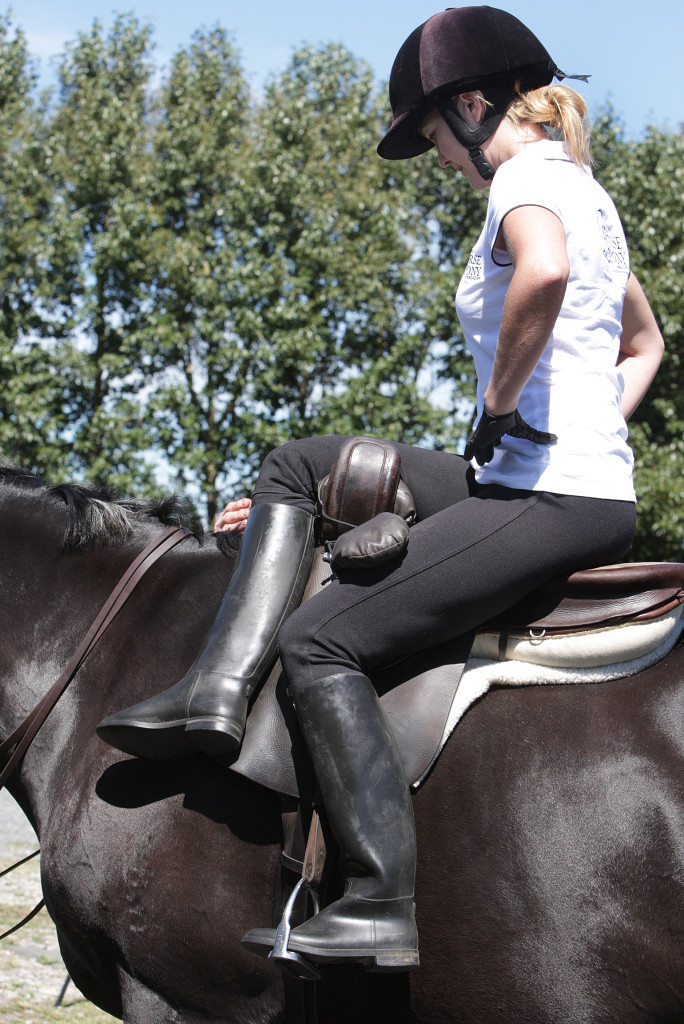
Side-saddles have two pommels, the ‘fixed head’ and the ‘leaping head’, and a single stirrup. For extra stability, a surcingle is secured over top of the leather three-fold girth, and a balance strap is fixed diagonally to prevent twisting. The seat is flat and often suede for added ‘stickiness’.
The underside of the side-saddle has a large surface area to distribute the rider’s weight to those sections of the horse’s back most capable of bearing it, and it’s flocked asymmetrically to ensure the saddle sits flat – like a table.
But like any saddle, it must fit the horse first and the rider second. Shirley measured the length of my thigh to see which saddle and horse would be suitable for my first lesson, and with a minor adjustment Shirley’s saddle sat me in the correct position – so Diva was going to be my mount for the lesson (sorry Basil). At first, it felt odd – but not uncomfortable. I felt immediately secure, and in case of disaster I was told how to use the emergency grip – if Diva decided to buck or shy (as if!), I’d avoid being thrown off by squeezing my thighs together against the pommels.
Diva was wearing a plain double bridle; a pelham is acceptable as well, but the reins are around 15cm longer than regular reins – this is because a side-saddle rider sits higher and further back.
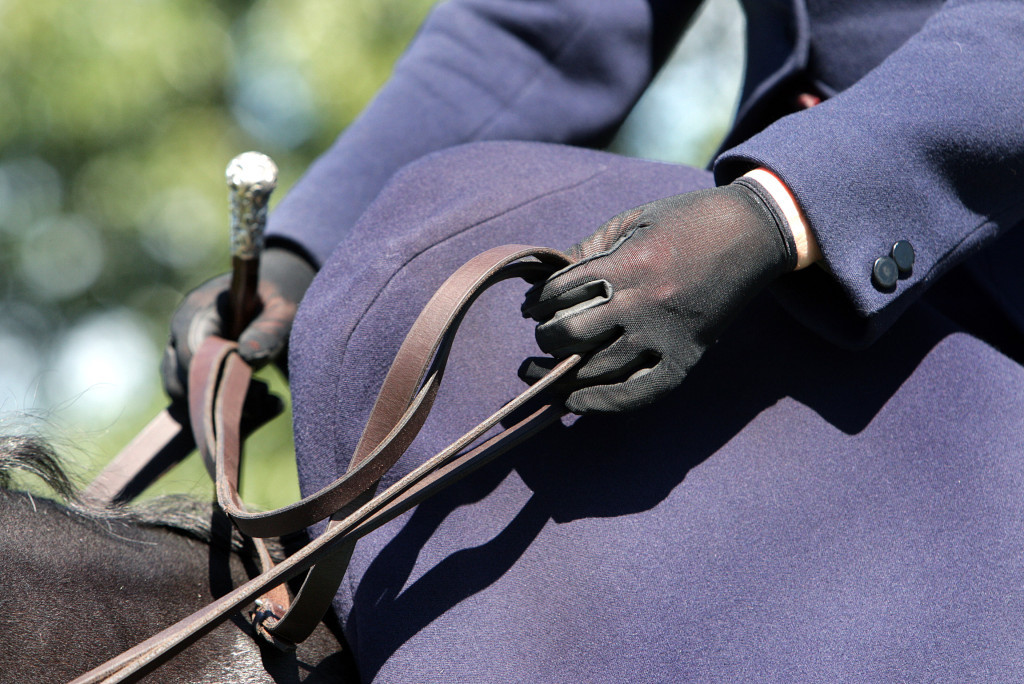
I started in walk to get a feel for the balance of my new position, with my hands either side of my knee and an instruction to lengthen the nape of my neck, shoulders back and chest up. According to The Principals of Modern Riding for Ladies, 1825 : “The rider’s head is always to be directed to the horse’s nose, her eye glancing on the ground the horse’s forefeet go over. In canter, the horse’s nose is always directed to the ground: the rider’s face is the same”.
We started on the right rein; this gave Diva a chance to warm up and get her balance. If I turned left too sharply it could easily over-balance the horse. Straightness is important; the horse’s shoulders should not pop out. Once the horse and the rider achieve straightness, the aids are similar to riding astride, but I did notice that I relied more on my hands than the seat and leg.
A leather cane must be carried in the right hand on a 45-degree angle. It’s a true example of an artificial aid, as it’s used on the off-side in absence of your leg. It’s used to apply pressure, without the flicky, whippy action of a dressage whip. I couldn’t believe Diva half-passed from the pressure of the cane to the offside!

When I felt ready to trot, I pushed her with my left leg. Rising to the trot is out of the question, so all trot work is sitting. I found the trot most ungraceful – all I could feel was my butt slapping the saddle! It was rather uncomfortable and I kept apologising to Diva. So this is why side-saddle ladies preferred to miss trot altogether, and go straight from walk to canter.
I cannot lie – I was apprehensive about trying canter after merely 10 minutes in the saddle, but I was assured it was much more comfortable. The aid for canter was to move the stirrup (left) leg forward for left lead canter or back for right lead canter.
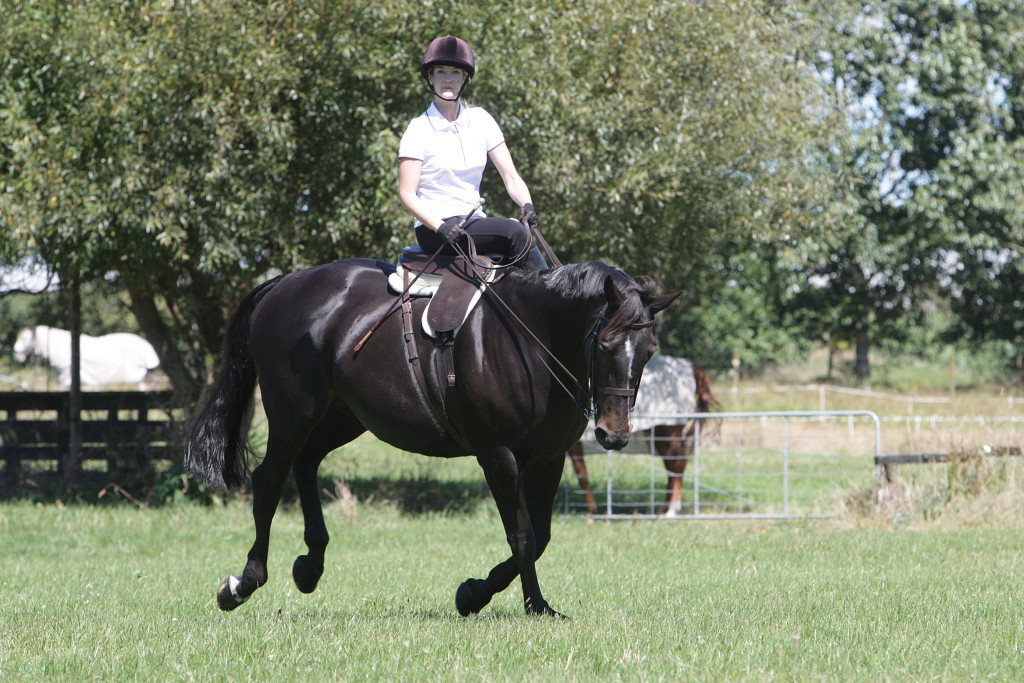
Diva was a superstar; she made this an easy task. Her rocking-chair canter felt amazing and I imagined myself on the Downton Abbey estate. The downward transition from canter to walk was easy, but to be honest I wouldn’t like to be riding a bolting horse side-saddle!
Right – now it was time to frock up, I had been looking forward to this the most! Historically, women’s riding attire wasn’t functional. The riding habit conformed to rules of social etiquette that preserved the reputation of a lady. Women who rode astride and opted for breeches were considered masculine and ‘unnatural’ – a lady should never bare her legs, so women rode in long, heavy skirts.
The outer layer of the riding habit – the coat and apron (skirt) – is tailored from heavy woollen fabric, cut to a shape that accentuates the feminine figure. Breeches or jodhpurs are worn under the apron, and must match the colour of the habit.The jacket should be long enough to cover the derriere, but should not touch the horse’s back.
Today’s aprons are actually half a skirt that covers both legs, and wraps around the back of the waist. This style is called a safety skirt because it lessens the chance of being caught on the pommels and being dragged to your death (I’m not joking).
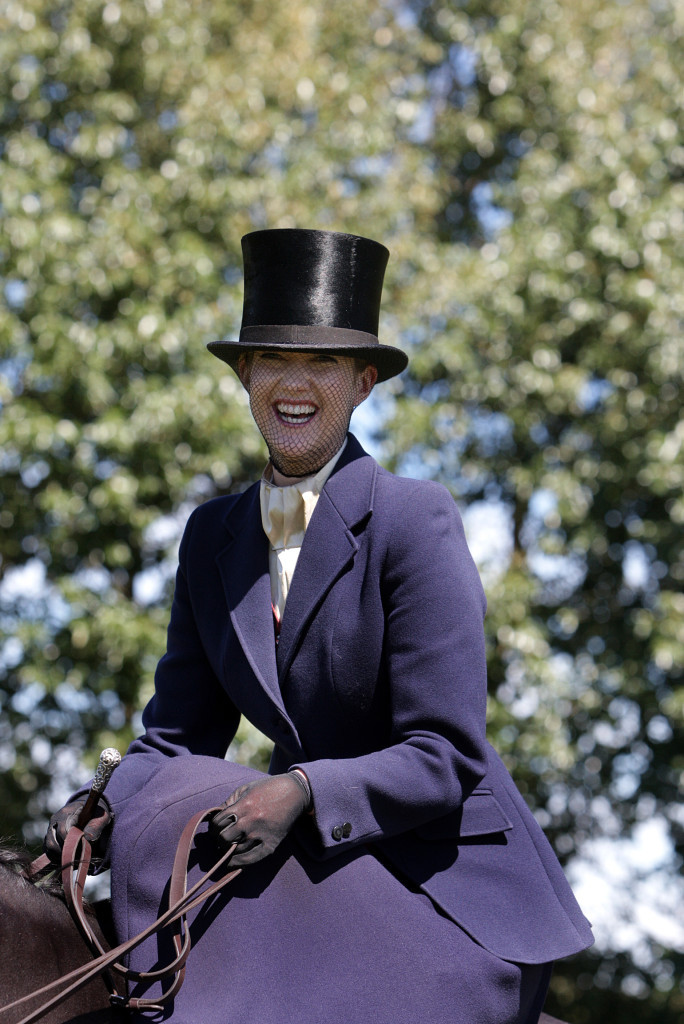 Tack and gloves must be brown leather, as traditionally black is reserved for mourning. Exceptions to the rule are a black hat and long boots, but black gloves are a no-no. Interestingly, there are rules matching the style of hat you wear to the bridle. A top hat, which must have a 5” crown and be made of silk or felt for wet weather, is only worn with a double bridle. If you ride in a snaffle or with a Pelham, a bowler hat is to be worn instead.
Tack and gloves must be brown leather, as traditionally black is reserved for mourning. Exceptions to the rule are a black hat and long boots, but black gloves are a no-no. Interestingly, there are rules matching the style of hat you wear to the bridle. A top hat, which must have a 5” crown and be made of silk or felt for wet weather, is only worn with a double bridle. If you ride in a snaffle or with a Pelham, a bowler hat is to be worn instead.
Mounting wasn’t an easy task…I looked around for my handy groom whose job it was to ensure I mount and dismount modestly and gracefully – alas, he was nowhere to be found. So I made do the peasant way, with a mounting block.

In one of the most ungraceful mounts in history, I accidentally hooked the apron around the pommels and almost went bottoms up. Once mounted and composed, I hacked around the paddocks with Tracey, feeling amazing – it’s impossible to wipe the smile from your face when you’re having such a great time. For this second ride, the saddle felt more natural.
Now converted, I want to know what type of horse suits side-saddle. Shirley says any horse can be used, providing they adjust to the saddle and weight of the rider.
“Some horses don’t take to it, no matter how much you try – others have no issues,” she says. It took Shirley four years of extensive searching and trialling to find Diva, but Tracey’s Basil was nearing the end of his competing days and he took to it like a duck to water – side-saddle has given him a new lease on life.
The ideal temperament is patient, calm and well mannered. A sensible yet forward-moving horse is preferred to a horse that requires persuasion to get moving. Conformationally, an ideal side-saddle mount is long-backed with a high head-carriage. The rider is elevated in the saddle, so a horse higher in front is preferred, to avoid the need for the rider to lean forward. A good sloping shoulder ensures a smooth gait. Horses with large movement and elevation aren’t ideal, as the movement is too big to enjoy.
Shirley and Tracey explain that modern horses are shorter-backed and broader than those bred 100 years ago, and this means that finding a suitable side-saddle horse is difficult, as the narrow gullets of antique saddles don’t fit.
There are limited side-saddles in New Zealand, so many look to the UK for antique saddles to bring back to life; a saddler with side-saddle knowledge can make a special flocked numnah to ensure an appropriate fit.
The New Zealand Side Saddle Association (NZSSA ) is the governing body for side-saddle and is affiliated with the English Side Saddle Association. It’s dedicated to preserving, improving the quality and promoting the art of side-saddle in New Zealand. https://newzealandsidesaddleassoc.tidyhq.com/

Origins of side-saddle
For 400 years, women on horseback were carried in a planchette, a small sideways seat with a footrest and high back, lead by a manservant.
The progression to the side-saddle allowed women freedom to ride independently yet maintain their modesty. This lasted until the 1930s, when the World Wars changed women’s role in society and the historic notions of acceptable ‘ladylike’ conduct.
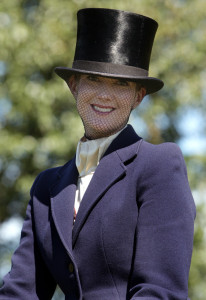 Competing in side-saddle
Competing in side-saddle
Turnout: Judged mounted, on the cleanliness, correctness and fitting of tack and the rider’s costume.
Concours d’Elegance: The most elegantly matched combination. While paces and riding are judged, more important still is the overall impression of elegance.
Best paced & mannered: Smooth paces and impeccable manners. No consideration is given to the horse’s age, breeding or conformation.
Best side-saddle mount: The judge looks for a horse with a good shoulder, smooth, free-going action that does not jolt the rider, and impeccable manners. A safe, comfortable and obedient ride.
Best side-saddle rider: A poised, elegant rider, straight and supple with her weight evenly distributed and hips and shoulders square to the front.
Unity class: Used to combine turnout, best horse and best rider in one event with points awarded one third for turnout, one third for horse and one third for rider.
Side-saddle equitation: A course of six fences is jumped, up to 50cm high for Novice or 80cm high for Open. Marks are awarded for rider’s position, correct style and horse’s presentation.
- This article was first published in the April 2012 issue of NZ Horse & Pony

